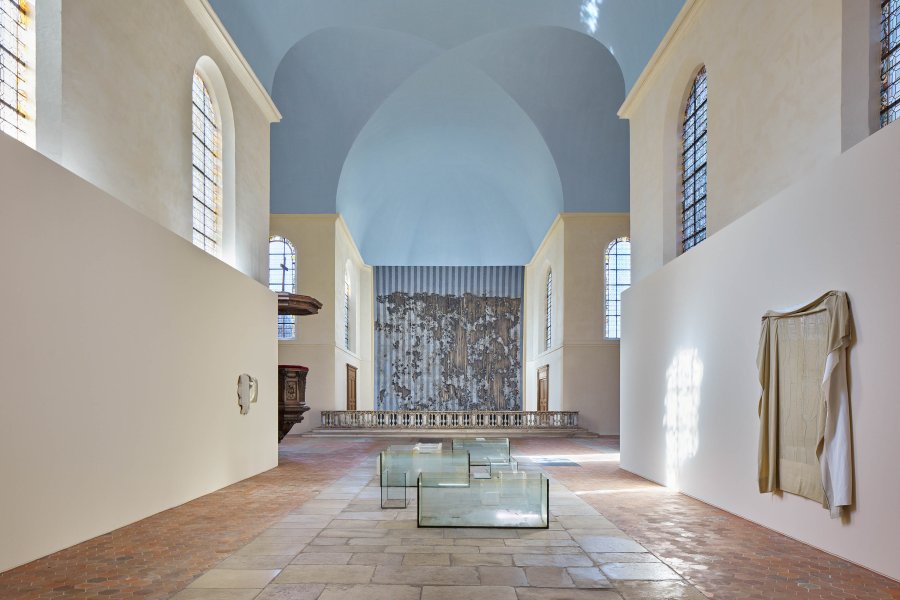Curated by
Emma Lavigne
Alexandra Bordes
On 17-18 September 2022, Kering participated for the seventh time in a row in the European Heritage Days, welcoming the public to its headquarters, the former Laennec Hospital located at 40 rue de Sèvres in Paris.
The force of Edith Dekyndt’s work stems from her belief that every object is a living organism that interferes and resonates with its host environment. As an artist, she is constantly reconsidering humans’ place in the world and their relationship to their surroundings. In its articulation of the discrepancies between appearance and reality, subjectivity and nature, and inertia and life, Edith Dekyndt’s work asks us to rethink our expectations and habits, ultimately to open our eyes.
Titled Aria of Inertia, the exhibition confronts us with the power of being in the world, even for the humblest expressions of life. All the works presented here, from the monumental to the most intimate, emphasise this vitality. The exhibition resonates with the theme of the 2022 Heritage Days of “Sustainable Heritage”.
The first piece that viewers entering the space encounter is titled Visitation Zone (2020), a set of vivaria and aquaria from the Riga Zoo that had initially been featured in the biennial that took place in Latvia’s capital that same year. Now ins-talled in the Laennec chapel, Visitation Zone reactivates issues near and dear to the artist’s heart: decomposition, disappearance, and interaction. As recurring figures and forms of preservation in the artist’s work, the empty aquaria and vivaria leave traces of the animals who once occupied them: smudges, dust, scratches, cracks, and dirtying marks. This ghostly sculptural ensemble is accompanied by a choreography in which a woman moves about slowly, making ordinary gestures (moving and cleaning things) that nevertheless pay close attention to the surrounding space that the glass containers have structured. These domestic gestures—often performed by women and generally far from view, before opening to the public, to customers, or to visitors—highlight an ambiguous alliance shrouded in a mysterious spirituality. Laennec’s long history of monks who cared for the incurably ill resonates anew in this chapel through this piece.
Edith Dekyndt continues her exploration of her favourite materials alongside this work: “light, water, and fabrics that move, transform, and even disappear”. Like Visitation Zone, they become vectors of this inertia that is rendered commonplace, an ambiguous appropriation that pushes back against domestication, overcomes sepa-rations, and overturns a sense of authority.
In an interplay of light between the vivaria placed on the ground and the stained-glass windows of this former church, a velvet fabric recalls the artist’s connec-tion to the textile industries of northern France and its delicate embroideries, which she has rendered even more complex through the use of broken glass. What has been broken has here been repaired and reconstituted. Edith Dekyndt uses these two, highly ordinary materials – fabric and glass – to provide us with sublimated images and moments that arise from natural, physical processes which generate these effects and metamorphoses ad infinitum.
In the main nave, before the altar, hanging some seven meters in the air, is a textile made of blue and white stripes. This fabric was previously buried directly in the ground for several months: minerals, roots, bacteria, and insects all left their mark on it, creating transparencies in some places and reliefs in others. Some parts of the fabric were only lightly damaged, while others were completely consumed. Like a terrestrial extension of the ceiling from which it hangs, the work is both ghostly and deeply rooted in a sense of materiality. It plunges viewers into “a fantastical dimension in which inani-mate objects come to life”.
Echoing the works created for Laennec, the pieces from the Collection, from Winter Drums 06 B (Tryptic), 2017 to Winter Drums 04, 2016, Blood lacque 013, 2017, and The Kingdom (Morsum 08), 2017, bear witness to her visual, almost alchemical research, which has led her to use the most diverse materials (from resin to horse blood, fabric, acrylic glass, and beyond) to achieve a certain purity of thought and contemplation. In her frequent use of symbolically laden organic materials, the artist asks us to confront the inescapable transformation of life by pointing to what remains imperceptible for being ephemeral and, thus, inherently variable.



